Consent & Survey
Surveys of State, Tribal, Local and Territorial (STLT) Governmental Health Agencies
DYK_ATTACH-B_Word_Survey_2011-08-036
Needs and Perceptions of Did You Know
OMB: 0920-0879
ATTACHMENT B: “Did You Know?” Word Document Survey Instrument
Consent Form
Form
approved
OMB No. 0920-0879
Expiration Date: 03/31/2014
Welcome! Thank you for agreeing to help the Centers for Disease Control and Prevention (CDC) evaluate "Did You Know?". Your feedback is extremely important. We anticipate that it will take approximately 10-15 minutes to complete these questions.
We are trying to understand your needs related to the "Did You Know?" and get your feedback on these e-mails provided to you weekly from CDC.
Your responses to all questions will be kept in a secure manner. No personal identifiers will be recorded unless you chose to provide them. All information is used for evaluation purposes only.
To proceed through the survey, select your answer for each question and click "Continue".

Public reporting burden of this collection of information is estimated to average 10-15 minutes per response, including the time for reviewing instructions, searching existing data sources, gathering and maintaining the data needed, and completing and reviewing the collection of information. An agency may not conduct or sponsor, and a person is not required to respond to a collection of information unless it displays a currently valid OMB control number. Send comments regarding this burden estimate or any other aspect of this collection of information, including suggestions for reducing this burden to CDC/ATSDR Reports Clearance Officer; 1600 Clifton Road NE, MS D-74, Atlanta, Georgia 30333; ATTN: PRA (0920-0735)
Demographic Questions
What is your primary work location? (Select one)
State, tribal, local or territorial public health department
Non-governmental organization (such as NACCHO, ASTHO, state health organizations, community-based organizations) [if selected, end evaluation]
Academic institution [if selected, end evaluation]
Hospital or medical center [if selected, end evaluation]
Other private health-related business (such as a health plan, physician's office, pharmaceutical company) [if selected, end evaluation]
Other, please describe:_____________________ [if selected, end evaluation]
What public health organization do you work for? (e.g. Hudson County Health Department)
_____________________________________________
Which specific U.S. state, tribe, territory, Pacific Island, or the District of Columbia do you work in? (e.g. Georgia, Navajo Nation, etc.)
________________________________
Which of the following best describes your job title or role in your organization? (Select all that apply)
Leader/Manager (e.g. Health Official, Public Health Director, Division or Program Director, etc.) [if selected, branch to Q#5]
Administrative/Clerical Staff
Behavioral Health Professional
Emergency Preparedness Coordinator or Staff
Environmental Health Coordinator/Sanitarian/Specialist/Scientist
Epidemiologist
Evaluation Staff
Fiscal Officer/Accountant
Health Communicator
Health Educator
Health Scientist
Information Technology Specialist
Laboratorian
Lawyer or Policy Advisor
Nurse
Nutritionist
Physician
Public Information Officer
Researcher
Other, please describe:_______________________
Which best describes the leadership role you currently hold? (Select all that apply)
Health Officer
Public Health Director
Nursing Administrator
Chief Sanitarian
Division Director
Program Director
Other, please describe: _________________________
Introductory Questions
Currently "Did You Know?" e-mails are sent every Friday morning. What is the best day for you to read "Did You Know?" e-mails? (Select one)
Sunday
Monday
Tuesday
Wednesday
Thursday
Friday
Saturday
No day is a good day [if selected, branch to Q#7]
Please explain why there is no good day for you to read "Did You Know?" (Select all that apply)
I am too busy to read "Did You Know?"
I get too many e-mails from CDC
I get too many e-mails in general
I don't find the information in the e-mail relevant to my work
I don't find the information in the e-mail interesting
I am not sure what is in the e-mails
I don't think to read the e-mails
I don't notice the e-mails
Other, please describe: _____________________
How often would you like to receive "Did You Know?" emails? "Did You Know?" currently comes once a week. (Select one)
Daily
Several times a week
Once a week
Several times a month
Once a month
Several times a year
Once a year
Never
It depends [if selected, branch to Q#9]
Why does it depend?
__________________________________________________________________________________________________________________________________________________________________________________________
To who have you forwarded the "Did You Know?" email(s)? (Select all that apply)
Colleagues/peers at work
Leadership at work
Employees or staff that I supervise or manage at work
Partner or community organizations
General public/constituents
Family/friends
I have not forwarded the email(s) [if selected, branch to Q#11]
Other, please describe: ______________________
If you haven't forwarded the emails, why? (Select all that apply)
I didn't think the information in the emails would be interesting to others
I didn't think the information in the emails would be relevant to others
I didn't think to forward the emails
I didn't have time to forward the emails
I didn't notice the emails
Other, please describe: ________________________
Task Questions (respondents see 1 of 7 randomly selected)
Task #1
Please read the following "Did You Know?", then scroll down to answer a question. When you are done, click "continue" at the bottom right of this window to go to the next question.
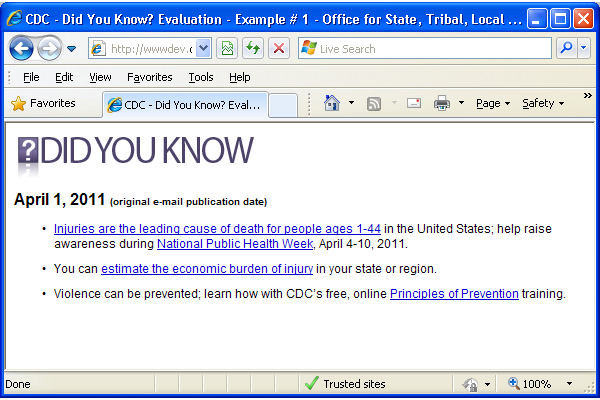
Please rate the following statements based on what you just read.
|
Strongly Disagree |
Disagree |
Neither Agree nor Disagree |
Agree |
Strongly Agree |
|
|
|
|
|
|
|
|
|
|
|
|
|
|
|
|
|
|
In a moment, you will be taken back to the same "Did You Know?" that you just saw. Now, please decide which link most catches your attention.
Scroll down to answer the question, then click "continue" at the bottom right of this window to go to the next question.

Which link did you choose?
Injuries are the leading cause of death for people ages 1-44 in the United States;
help raise awareness during National Public Health Week, April 4-10, 2011.
You can estimate the economic burden of injury in your state or region.
Violence can be prevented; learn how with CDC's free, online Principles of Prevention training.
Task #2
Please read the following "Did You Know?", and then scroll down to answer a question. When you are done, click "continue" at the bottom right of this window to go to the next question.
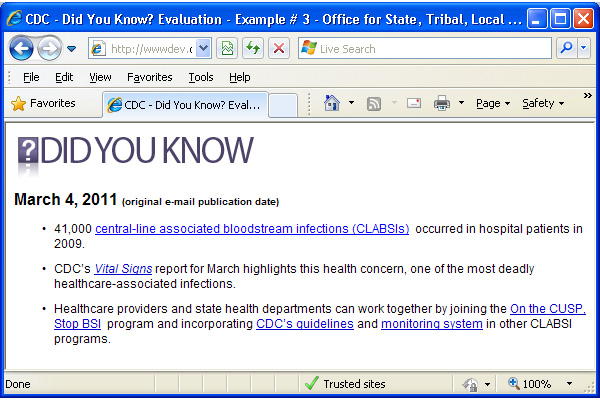
Please rate the following statements based on what you just read.
|
Strongly Disagree |
Disagree |
Neither Agree nor Disagree |
Agree |
Strongly Agree |
|
|
|
|
|
|
|
|
|
|
|
|
|
|
|
|
|
|
In a moment, you will be taken back to the same "Did You Know?" that you just saw. Now, please decide which link most catches your attention.
Scroll down to answer the question, then click "continue" at the bottom right of this window to go to the next question.

Which link did you choose?
41,000 central-line associated bloodstream infections (CLABSIs) occurred in hospital patients in 2009.
CDC's Vital Signs report for March highlights this health concern, one of the most deadly healthcare-associated infections.
Healthcare providers and state health departments can work together by joining the On the CUSP, Stop BSI program
and incorporating CDC's guidelines
and monitoring system in other CLABSI programs.
Task #3
Please read the following "Did You Know?", and then scroll down to answer a question. When you are done, click "continue" at the bottom right of this window to go to the next question.
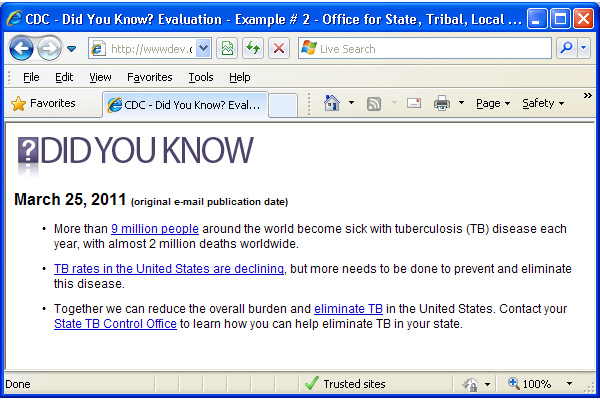
Please rate the following statements based on what you just read.
|
Strongly Disagree |
Disagree |
Neither Agree nor Disagree |
Agree |
Strongly Agree |
|
|
|
|
|
|
|
|
|
|
|
|
|
|
|
|
|
|
In a moment, you will be taken back to the same "Did You Know?" that you just saw. Now, please decide which link most catches your attention.
Scroll down to answer the question, and then click "continue" at the bottom right of this window to go to the next question.

15. Which link did you choose?
More than 9 million people around the world become sick with tuberculosis (TB) disease each year, with almost 2 million deaths worldwide.
TB rates in the United States are declining, but more needs to be done to prevent and eliminate this disease.
Together we can reduce the overall burden and eliminate TB in the United States.
Contact your State TB Control Office to learn how you can help eliminate TB in your state.
Task #4
Please read the following "Did You Know?", and then scroll down to answer a question. When you are done, click "continue" at the bottom right of this window to go to the next question.
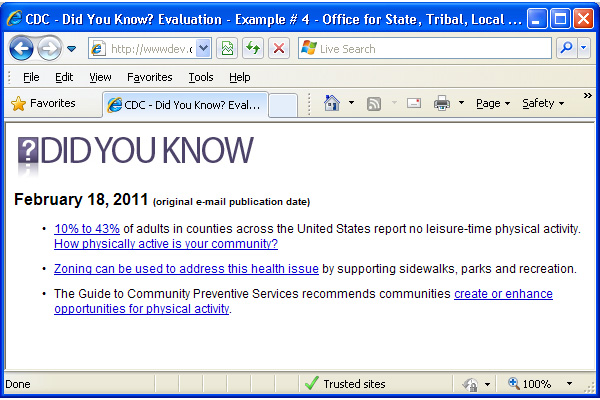
Please rate the following statements based on what you just read.
|
Strongly Disagree |
Disagree |
Neither Agree nor Disagree |
Agree |
Strongly Agree |
|
|
|
|
|
|
|
|
|
|
|
|
|
|
|
|
|
|
In a moment, you will be taken back to the same "Did You Know?" that you just saw. Now, please decide which link most catches your attention.
Scroll down to answer the question, and then click "continue" at the bottom right of this window to go to the next question.

Which link did you choose?
10% to 43% of adults in counties across the United States report no leisure-time physical activity.
How physically active is your community?
Zoning can be used to address this health issue by supporting sidewalks, parks and recreation.
The Guide to Community Preventive Services recommends communities create or enhance opportunities for physical activity.
Task #5
Please read the following "Did You Know?", and then scroll down to answer a question. When you are done, click "continue" at the bottom right of this window to go to the next question.
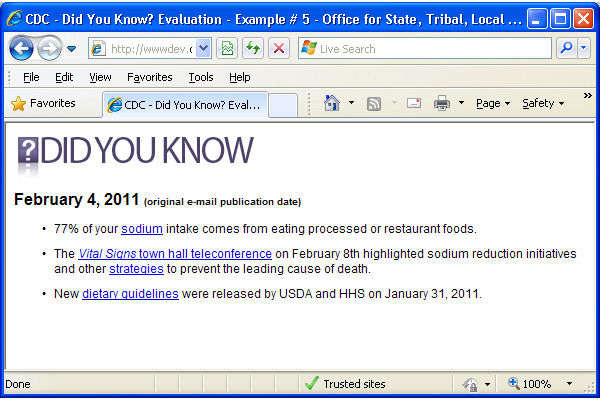
Please rate the following statements based on what you just read.
|
Strongly Disagree |
Disagree |
Neither Agree nor Disagree |
Agree |
Strongly Agree |
|
|
|
|
|
|
|
|
|
|
|
|
|
|
|
|
|
|
In a moment, you will be taken back to the same "Did You Know?" that you just saw. Now, please decide which link most catches your attention.
Scroll down to answer the question, and then click "continue" at the bottom right of this window to go to the next question.

Which link did you choose?
77% of your sodium intake comes from eating processed or restaurant foods.
The Vital Signs town hall teleconference on February 8th highlighted sodium reduction initiatives
and other strategies to prevent the leading cause of death.
New dietary guidelines were released by USDA and HHS on January 31, 2011.
Task #6
Please read the following "Did You Know?", and then scroll down to answer a question. When you are done, click "continue" at the bottom right of this window to go to the next question.
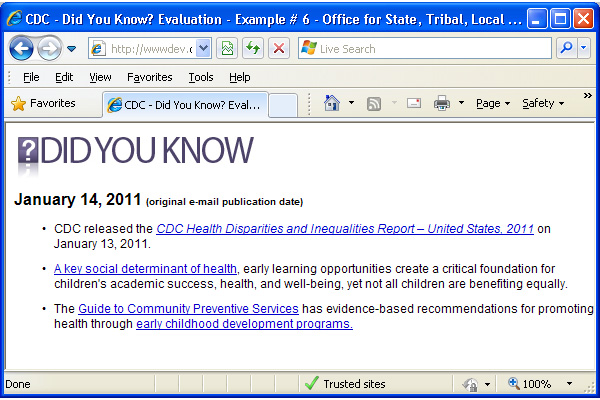
Please rate the following statements based on what you just read.
|
Strongly Disagree |
Disagree |
Neither Agree nor Disagree |
Agree |
Strongly Agree |
|
|
|
|
|
|
|
|
|
|
|
|
|
|
|
|
|
|
In a moment, you will be taken back to the same "Did You Know?" that you just saw. Now, please decide which link most catches your attention.
Scroll down to answer the question, and then click "continue" at the bottom right of this window to go to the next question.

Which link did you choose?
CDC released the CDC Health Disparities and Inequalities Report – United States, 2011 on January 13, 2011.
A key social determinant of health, early learning opportunities create a critical foundation for children's academic success, health, and well-being, yet not all children are benefiting equally.
The Guide to Community Preventive Services has evidence-based recommendations
for promoting health through early childhood development programs.
Task #7
Please read the following "Did You Know?", and then scroll down to answer a question. When you are done, click "continue" at the bottom right of this window to go to the next question.
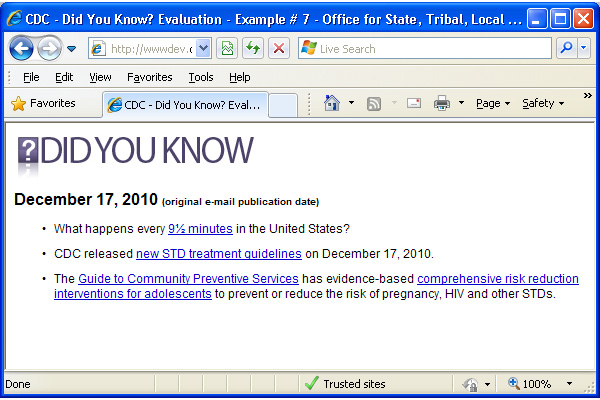
Please rate the following statements based on what you just read.
|
Strongly Disagree |
Disagree |
Neither Agree nor Disagree |
Agree |
Strongly Agree |
|
|
|
|
|
|
|
|
|
|
|
|
|
|
|
|
|
|
In a moment, you will be taken back to the same "Did You Know?" that you just saw. Now, please decide which link most catches your attention.
Scroll down to answer the question, and then click "continue" at the bottom right of this window to go to the next question.

Which link did you choose?
What happens every 9½ minutes in the United States?
CDC released new STD treatment guidelines on December 17, 2010.
The Guide to Community Preventive Services has evidence-based
comprehensive risk reduction interventions for adolescents to prevent or reduce the risk of pregnancy, HIV and other STDs.
Follow-up Questions
What is the reason/reason(s) you chose this link? (Select all that apply) I found the information interesting
I found the information relevant to my work
I found the information relevant to my personal life
I found the information relevant to my jurisdiction or local area
I found the information actionable
I found the information timely
I found the information unusual
I found the information practical
I found the information credible
Other, please describe: ___________________________
Please select the top five (5) types of content that you would like to see in a future "Did You Know?" (Select only 5)
Newly released data and statistics Updated policy information
Information relevant to my local community Upcoming events such as conferences, meetings, grand rounds, etc.
Information on what other jurisdictions are doing in public health Free resources and materials
New CDC guidelines and recommendations Workforce development materials including training
Evidence-based strategies Performance improvement information
New journal articles and publications
Other, please describe: _________________________
Each week, "Did You Know?" consists of three bullets of information and resources on a single topic. Based on this information, please answer the following questions.
How many topics per email do you think are appropriate? (Select one)
1
2
3
4
5
More than 5
It depends [if selected, branch to Q#19]
Please explain why it depends.
__________________________________________________________________________________________________________________________________________________________________________________________
What topics are you interested in seeing for "Did You Know?" in the future?
__________________________________________________________________________________________________________________________________________________________________________________________________
For the next question, you will see a list of several past "Did You Know?" e-mails. Please review all of the text and then click "continue" to answer a few questions about what you have read.
Scroll to read all of the content below. Then, click "continue" at the bottom right of this window to go to the next question.
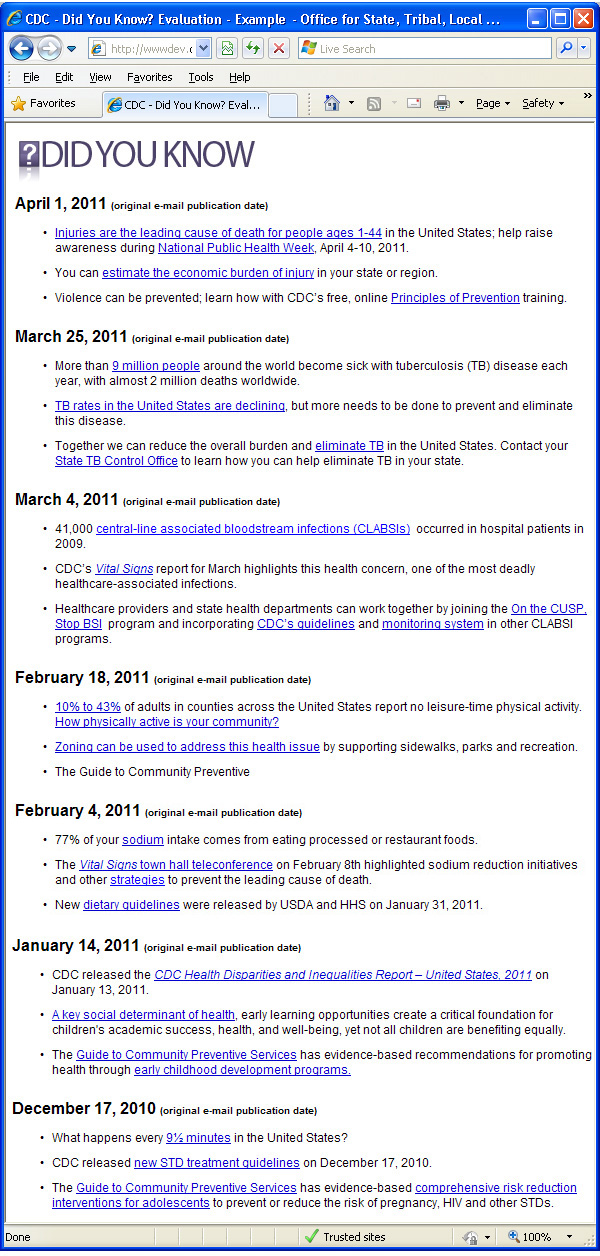
Based on what you have just read, who do you think is the primary intended audience for "Did You Know?" (If you need to read the e-mails again, click the "previous" button to go back.) (Select all that apply)
Consumers/general public
Healthcare providers
Local public health professionals
Policy makers
Public health leadership
Researchers
State public health professionals
Teachers and students
Territorial public health professionals
Tribal public health professionals
"Did You Know?" emails have been distributed since December 10, 2010. Since then, have you used the information from the weekly emails to inform or support practices or policies in your work? (Select one)
Yes, I have applied the information into practice [if selected, branch to Q#23]
No, the information has not changed how I do my work
Please provide a description of the practice or policy that you informed or supported using the information in "Did You Know?", how you were able to accomplish the change, and any impact you have noticed so far.
__________________________________________________________________________________________________________________________________________________________________________________________
How can we improve the "Did You Know?" content to make it more useful to your work or to help inform or support practices or policies in your workplace?
__________________________________________________________________________________________________________________________________________________________________________________________________
Please provide the email address at which you receive "Did You Know?" (OPTIONAL) IMPORTANT! This question is optional; however, we would like your email address in order to verify that you are indeed a recipient of "Did You Know?" It will not be used to contact you, be shared with anyone, or used to link your identity with any answers you have provided in this survey.
___________________________________________
| File Type | application/vnd.openxmlformats-officedocument.wordprocessingml.document |
| Author | McAvoy, Melissa (CDC/OSTLTS/OD) |
| File Modified | 0000-00-00 |
| File Created | 2021-02-01 |
© 2026 OMB.report | Privacy Policy